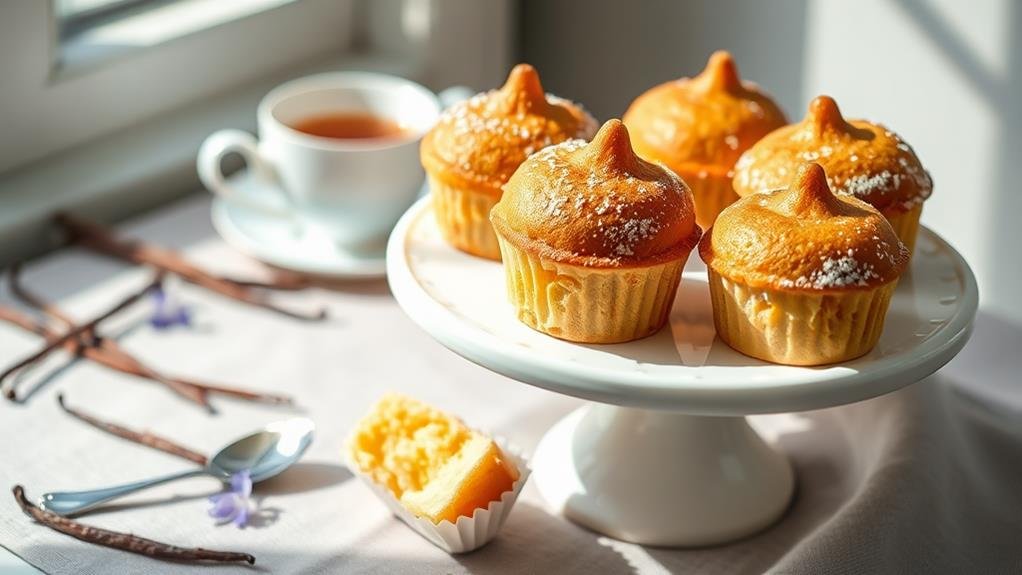Vanilla cakelets are a real treat to make, and I've been baking these little gems for longer than I care to remember. They're not fancy, just good, honest mini cakes that always hit the spot.
Now, these aren't just regular cakes made smaller – they need their own special touch. The trick is getting them just right, and I'll tell you exactly how I do it. After years of tweaking and testing in my kitchen, I've found that these little cakes need careful watching, as they can go from perfect to overdone in the blink of an eye.
You want a nice, soft middle that springs back when you touch it, and a light golden top that makes you smile. The vanilla should come through clear and clean – none of that artificial business. I always say if you're going to bake something this simple, use the best vanilla you can get your hands on.
The secret's in treating these small cakes with respect – not too hot an oven, not too much mixing, and keeping a close eye on the timer. Think of them as delicate little things that need gentle handling, just like my mother taught me all those years ago.
Trust me on this – once you get the hang of these cakelets, they'll become a regular in your baking routine. They're just right for when the neighbors pop in, or when you want something nice but not too fussy with your afternoon cup of tea.
Recipe

A vanilla cakelet is a miniature version of a traditional vanilla cake, offering the perfect individual serving size for desserts, tea parties, or special occasions. These delicate treats feature a light, moist crumb and pure vanilla flavor that makes them an enduring favorite among both children and adults. Similar to how gingerbread cookies have a rich history, vanilla cakelets bring a delightful touch to festive gatherings.
Making vanilla cakelets requires precision in measuring and mixing to achieve the perfect texture. These small cakes can be served plain, dusted with powdered sugar, or decorated with frosting and sprinkles. Their compact size makes them ideal for portion control while still delivering the satisfying taste of a full-sized cake.
Ingredients:
- 1½ cups all-purpose flour
- 1½ teaspoons baking powder
- ¼ teaspoon salt
- ½ cup unsalted butter, softened
- 1 cup granulated sugar
- 2 large eggs
- 2 teaspoons pure vanilla extract
- ½ cup whole milk
- ¼ cup vegetable oil
- ⅛ teaspoon baking soda
Preheat oven to 350°F (175°C). Whisk dry ingredients in a bowl. In a separate bowl, cream butter and sugar until light and fluffy. Add eggs one at a time, then vanilla. Gradually mix in dry ingredients alternating with milk and oil until just combined. Fill greased cakelet molds ¾ full. Bake for 15-18 minutes until a toothpick comes out clean. Cool in pan for 5 minutes before removing.
For best results, guarantee all ingredients are at room temperature before mixing. Avoid overmixing the batter as this can lead to tough cakelets. If using decorative molds, grease them thoroughly and dust with flour to prevent sticking. These cakelets can be made ahead and frozen for up to three months when stored in an airtight container.
These delicate vanilla cakelets first gained popularity in 19th century French patisseries as petits gâteaux, serving as elegant single-portion desserts for afternoon tea.
The miniature cakes deliver a concentrated vanilla flavor in a perfectly sized portion, making them ideal for both casual snacking and formal entertaining.
While traditional recipes called for vanilla beans sourced from French colonies, modern versions typically use pure vanilla extract without sacrificing the characteristic warm, floral notes.
Their diminutive size allows the buttery, tender crumb to develop fully during baking, creating a more consistent texture than larger cakes.
Conclusion
Proper vanilla cakelets are a joy to make, and I've baked these little beauties more times than I can count. Now, you'll want your oven good and hot at 350°F (that's 175°C for those who prefer metric). Trust me on the timing here – spend a full 3 minutes creaming your mixture, no shortcuts. When you're adding those eggs, give each one a good 30 seconds to mix in properly. It might seem fussy, but it's what makes these cakelets turn out just right.
I've learned over the years that treating these little cakes with respect – measuring carefully and watching your temperatures – pays off every time. Nothing fancy about them, just honest, good vanilla flavor that comes through when you do things properly. The finished cakelets should be light and moist, just the way a proper cake ought to be. Simple as that – no tricks, no fuss, just good, careful baking.

